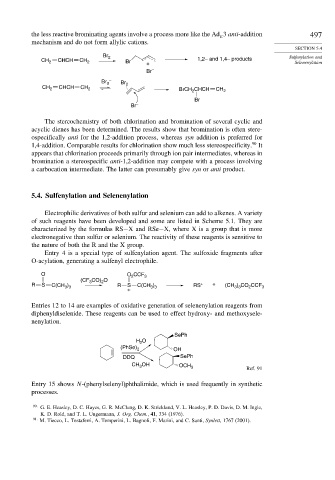Page 516 - Advanced Organic Chemistry Part A - Structure and Mechanisms, 5th ed (2007) - Carey _ Sundberg
P. 516
the less reactive brominating agents involve a process more like the Ad 3 anti-addition 497
E
mechanism and do not form allylic cations.
SECTION 5.4
Br 2 Sulfenylation and
CH 2 CHCH CH 2 Br + 1,2– and 1,4– products Selenenylation
Br –
Br 3 – Br 2
CH 2 CHCH CH 2 BrCH CHCH CH 2
2
Br
Br –
The stereochemistry of both chlorination and bromination of several cyclic and
acyclic dienes has been determined. The results show that bromination is often stere-
ospecifically anti for the 1,2-addition process, whereas syn addition is preferred for
90
1,4-addition. Comparable results for chlorination show much less stereospecificity. It
appears that chlorination proceeds primarily through ion pair intermediates, whereas in
bromination a stereospecific anti-1,2-addition may compete with a process involving
a carbocation intermediate. The latter can presumably give syn or anti product.
5.4. Sulfenylation and Selenenylation
Electrophilic derivatives of both sulfur and selenium can add to alkenes. A variety
of such reagents have been developed and some are listed in Scheme 5.1. They are
characterized by the formulas RS−X and RSe−X, where X is a group that is more
electronegative than sulfur or selenium. The reactivity of these reagents is sensitive to
the nature of both the R and the X group.
Entry 4 is a special type of sulfenylation agent. The sulfoxide fragments after
O-acylation, generating a sulfenyl electrophile.
O O 2 CCF 3
(CF CO) O
3
2
R S C(CH ) R S C(CH ) RS + + (CH ) CO CCF 3
3 3
3 3
2
3 3
+
Entries 12 to 14 are examples of oxidative generation of selenenylation reagents from
diphenyldiselenide. These reagents can be used to effect hydroxy- and methoxysele-
nenylation.
SePh
H O
2
(PhSe) 2 OH
DDQ SePh
CH OH OCH 3 Ref. 91
3
Entry 15 shows N-(phenylselenyl)phthalimide, which is used frequently in synthetic
processes.
90 G. E. Heasley, D. C. Hayes, G. R. McClung, D. K. Strickland, V. L. Heasley, P. D. Davis, D. M. Ingle,
K. D. Rold, and T. L. Ungermann, J. Org. Chem., 41, 334 (1976).
91
M. Tiecco, L. Testaferri, A. Temperini, L. Bagnoli, F. Marini, and C. Santi, Synlett, 1767 (2001).

